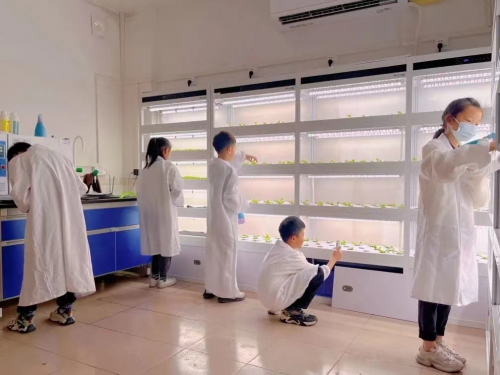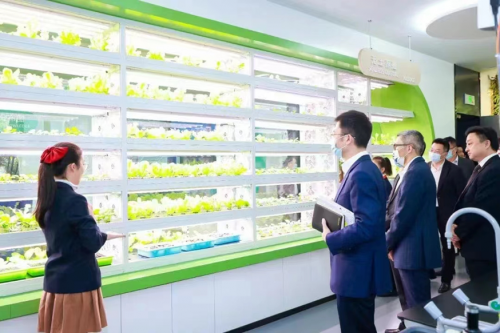Indoor vertical farm is an emerging concept in the agricultural field in recent years. By planting crops on indoor vertical shelves through scientific and technological means, it can achieve multiple harvests throughout the year, reduce soil erosion, avoid desertification, and effectively ease the pressure on food supply in cities. In order to let more people understand the concept, technology and advantages of indoor vertical farm, many indoor vertical farm enterprises cooperate with local science education institutions to bring it to the forefront of science education and convey the concept of scientific and technological innovation and sustainable development to the public.
With the improvement of people's awareness of health and environmental protection, organic farming has attracted more and more attention. In order to promote the concept and technology of organic planting, Aoma Agriculture has introduced soilless organic planting into popular science education, providing a more healthy, safe and environmentally friendly vegetable planting method for the general public.

1.Partner introduction
In the Youth Activity Center of Yaohai District, Guangdong Aoma Agricultural Technology Co., Ltd. built a smart agricultural hydroponics laboratory in Hefei, Anhui Province. The science education institution is a famous local science education institution, with a professional science education team and perfect educational facilities, committed to passing on the concept of science and technology, environmental protection and sustainable development to the public. The students participated in the planting of this project and felt the perfect combination of labor and technology. Different from the previous working experience, the charm of smart agriculture opened the eyes of the children. Unconsciously, the seeds of the prosperity of science and technology have been quietly planted in the hearts of the children. Let the students know the power of modern science and technology to bring agricultural development, let the students contribute to the development of agriculture in the future.

2. Event planning and execution In order to bring indoor vertical farms to the forefront of popular science education, the partners jointly planned an indoor vertical farm popular science exhibition. The event is divided into three parts: exhibition, talks and field visits. 2.1. Project presentation The exhibition section mainly introduces the concept, characteristics and advantages of indoor vertical farm to visitors by displaying on-site indoor vertical farm equipment and technologies. The exhibition includes: basic principles of indoor vertical farm, vertical shelf design, planting methods, growth light control, water and fertilizer circulation system, etc. In addition, the exhibition also shows the production process, planting planning and product sales of indoor vertical farm enterprises, so that visitors can understand the industrial chain and business model of indoor vertical farm. Through the exhibition, visitors can gain an in-depth understanding of the technology and application of indoor vertical farms, and understand the future development direction and challenges of urban agriculture.

2.2. Hardware and software ecology The hardware part has built a plant plant planting module independently developed by Guangdong Aoma Agricultural Technology Co., LTD. The added collection part includes temperature and humidity transmitter, CO2 sensor, EC sensor, PH sensor, PM2.5/10 sensor, light intensity sensor, water temperature sensor, atmospheric pressure sensor, and corresponding hardware control equipment such as: co2 generator, hydroponic fertilizer regulator, O3 generator, artificial light source and many other plant plant facilities and equipment. The above sensors use the gateway and iot modules of Guangdong Aoma Agricultural Technology Co., Ltd. to realize hardware mobilization and automated linkage; For example, the user can set the CO2 target value through the Auma digital agriculture system, the CO2 sensor will upload the collected data to Auma through the Auma agricultural gateway, and the V-AUMA02 digital agriculture management system can determine whether to turn on or off the CO2 generation system according to the target value set by the user. Users can also customize the light intensity and duration of the light source required for plant growth through the Auma digital agriculture system, and the light intensity data collected by the light sensor can be automatically turned on or off the light source of the plant fill light through the data interaction of Auma Agriculture and Smart gateway. All of the linked strategic tasks mentioned above can be carried out within Auma's digital agriculture management system to achieve the full digitization of the agricultural growing environment.

2.3. Modern agriculture science education lecture The lecture part is the core content of the activity, by inviting experts from indoor vertical farm enterprises and science education institutions to give on-site explanations, to convey the concept of scientific and technological innovation, sustainable development and ecological protection of indoor vertical farm to visitors. The lectures include: the basic concepts and principles of indoor vertical farms, the comparison between indoor vertical farms and traditional agriculture, the role of indoor vertical farms in urban agriculture and ecological protection, the combination of indoor vertical farms and Internet of Things technology, and the business model and market prospects of indoor vertical farms. Through the lectures, visitors can gain insight into the technological and commercial applications of indoor vertical farms and understand the development direction and challenges of modern agriculture.

2.4. Take a field trip The field visit part is one of the highlights of the activity, through visiting the actual production environment of indoor vertical farms, visitors can personally experience the equipment and technology of indoor vertical farms, and feel the ecological and economic benefits brought by indoor vertical farms. Visitors will wear appropriate protective equipment, enter the indoor vertical farm to observe equipment and plants, understand the various equipment and technologies required in the production process of indoor vertical farms, and can taste the products of indoor vertical farms. Through field visits, visitors can intuitively understand the production environment and production process of indoor vertical farms, and enhance their knowledge and understanding of indoor vertical farms.

3. Activity effects and results The indoor vertical farm science popularization exhibition has received extensive attention and support from all walks of life, with more than 200 people visiting the event. Visitors included students and teachers from popular science education institutions, local government officials, agricultural entrepreneurs and media reporters. The atmosphere at the event was lively, and visitors showed great interest and curiosity in the technological and commercial applications of indoor vertical farms. Through exhibitions, lectures and field visits, visitors have a deeper understanding and understanding of the technology and application of indoor vertical farms, and a clearer understanding of the development direction and challenges of modern agriculture. In addition, the event also achieved the following results: 1. It promotes the integration of popular science education and urban agriculture. By integrating the scientific and technological innovation of indoor vertical farms and the concept of urban agriculture into popular science education, more people can understand and understand the current situation and development direction of urban agriculture, and improve the public's awareness and awareness of urban agriculture and ecological protection. 2. Promoted the application and promotion of indoor vertical farms. By showing the production process, planting planning and product sales of indoor vertical farms, more people can understand the business model and market prospects of indoor vertical farms, and improve the public's awareness and confidence in indoor vertical farms. 3. Cooperation between enterprises, universities and research institutes has been strengthened. This activity invited experts from indoor vertical farm enterprises and science education institutions to explain, promoted industry-university-research cooperation and technical exchanges, and provided more support and cooperation opportunities for the research and development and promotion of indoor vertical farms.

Iv. Conclusion As an innovative urban agriculture model, indoor vertical farm has the characteristics of ecological environmental protection, resource conservation, high efficiency and stability, and is of great significance to the sustainable development and ecological protection of urban agriculture. By introducing indoor vertical farms into popular science education, more people can understand and understand the technical and commercial applications of indoor vertical farms, improve the public's awareness and confidence in modern agriculture, and promote the development and innovation of urban agriculture. Therefore, indoor vertical farm into popular science education is an effective way of promotion, worthy of widespread promotion and application.









